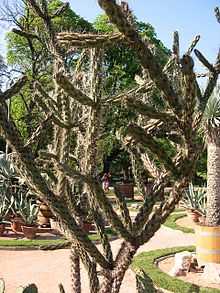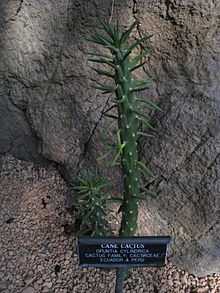Cylindropuntia
| Cholla | |
|---|---|
 | |
| Cylindropuntia kleiniae | |
| Scientific classification | |
| Kingdom: | Plantae |
| (unranked): | Angiosperms |
| (unranked): | Eudicots |
| (unranked): | Core eudicots |
| Order: | Caryophyllales |
| Family: | Cactaceae |
| Subfamily: | Opuntioideae |
| Tribe: | Cylindropuntieae |
| Genus: | Cylindropuntia (Engelm.) F.M.Knuth |
| Species | |
|
Numerous, see text | |

Cylindropuntia is a genus of cacti (family Cactaceae), containing the cholla.
Description
Cholla are native to northern Mexico and the Southwestern United States.
Cholla are known for their barbed spines that tenaciously attach to skin, fur, and clothing.
Stands of cholla are called 'chollas gardens' or 'cholla forests'. Individuals within these colonies often exhibit the same DNA as they were formerly tubercles of an original plant.
Classification
Cholla were formerly treated as a subgenus of Opuntia but have now been separated based on their cylindrical stems ('Opuntia' have flattened stems) and the presence of papery epidermal sheaths on the spines ('Opuntia' have no sheaths).[1] A few species of mat or clump forming opuntioid cacti are currently placed in the genus Grusonia.
There are about 35 species of Cylindropuntia native to the southwest and south central United States, Mexico and the West Indies, "The Flora of North America" recognizes 22 species. Some species have been introduced to South America (Chile, Ecuador, Peru) and South Africa.[2]
Selected species
- Cylindropuntia abyssi
- Cylindropuntia acanthocarpa - buckhorn cholla
- Cylindropuntia alcahes
- Cylindropuntia arbuscula - pencil cholla
- Cylindropuntia bigelovii - teddy-bear cholla
- Cylindropuntia californica
- Cylindropuntia caribaea
- Cylindropuntia cholla
- Cylindropuntia cylindrica - cane cactus
- Cylindropuntia echinocarpa - silver cholla
- Cylindropuntia fulgida - jumping cholla or hanging chain cholla
- Cylindropuntia imbricata - cane cholla, tree cholla
- Cylindropuntia kelvinensis
- Cylindropuntia kleiniae
- Cylindropuntia leptocaulis - desert Christmas cactus, Christmas Cholla, tasajillo
- Cylindropuntia mortolensis
- Cylindropuntia molesta - agujilla
- Cylindropuntia munzii
- Cylindropuntia prolifera
- Cylindropuntia ramosissima - diamond cholla
- Cylindropuntia rosea
- Cylindropuntia schottii - dog cholla
- Cylindropuntia spinosior - Tasajo cholla
- Cylindropuntia stanlyi - devil cholla
- Cylindropuntia tunicata
- Cylindropuntia × tetracantha
- Cylindropuntia versicolor - staghorn cholla
- Cylindropuntia × vivipara
- Cylindropuntia whipplei - rat-tail cholla
- Cylindropuntia wolfii
References
| Wikimedia Commons has media related to Cylindropuntia. |